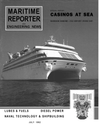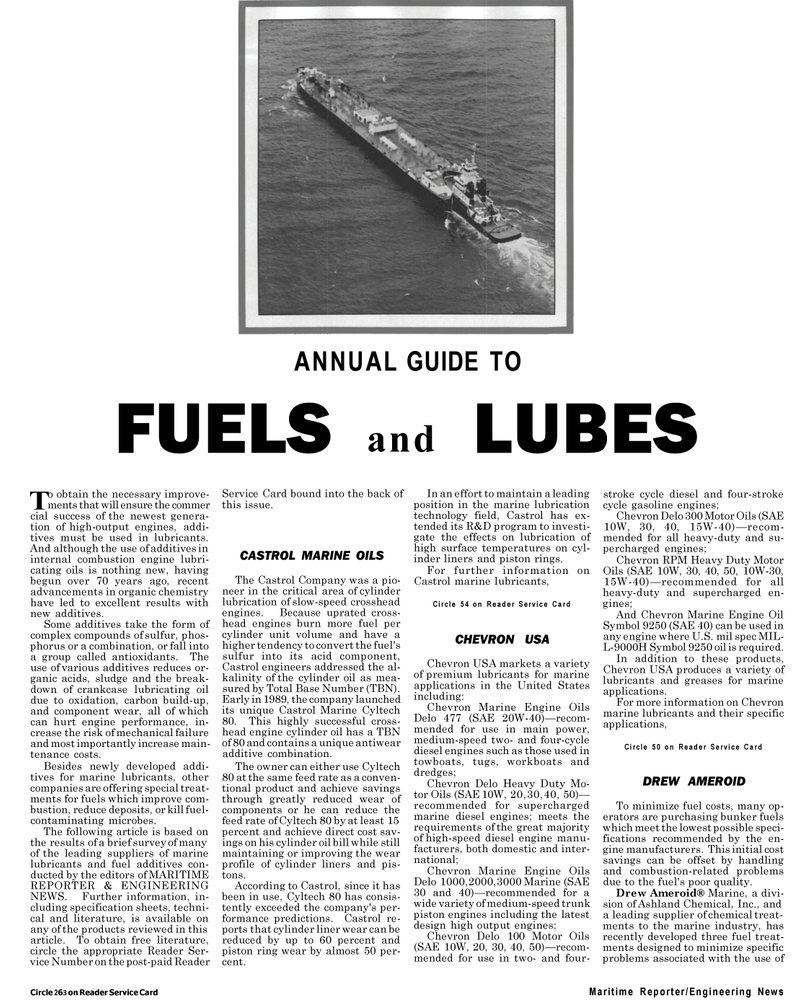
Page 42: of Maritime Reporter Magazine (July 1992)
Read this page in Pdf, Flash or Html5 edition of July 1992 Maritime Reporter Magazine
ANNUAL GUIDE TO
FUELS and LUBES
To obtain the necessary improve-ments that will ensure the commer cial success of the newest genera- tion of high-output engines, addi- tives must be used in lubricants.
And although the use of additives in internal combustion engine lubri- cating oils is nothing new, having begun over 70 years ago, recent advancements in organic chemistry have led to excellent results with new additives.
Some additives take the form of complex compounds of sulfur, phos- phorus or a combination, or fall into a group called antioxidants. The use of various additives reduces or- ganic acids, sludge and the break- down of crankcase lubricating oil due to oxidation, carbon build-up, and component wear, all of which can hurt engine performance, in- crease the risk of mechanical failure and most importantly increase main- tenance costs.
Besides newly developed addi- tives for marine lubricants, other companies are offering special treat- ments for fuels which improve com- bustion, reduce deposits, or kill fuel- contaminating microbes.
The following article is based on the results of a brief survey of many of the leading suppliers of marine lubricants and fuel additives con- ducted by the editors of MARITIME
REPORTER & ENGINEERING
NEWS. Further information, in- cluding specification sheets, techni- cal and literature, is available on any of the products reviewed in this article. To obtain free literature, circle the appropriate Reader Ser- vice Number on the post-paid Reader
Service Card bound into the back of this issue.
CASTROL MARINE OILS
The Castrol Company was a pio- neer in the critical area of cylinder lubrication of slow-speed crosshead engines. Because uprated cross- head engines burn more fuel per cylinder unit volume and have a higher tendency to convert the fuel's sulfur into its acid component,
Castrol engineers addressed the al- kalinity of the cylinder oil as mea- sured by Total Base Number (TBN).
Early in 1989, the company launched its unique Castrol Marine Cyltech 80. This highly successful cross- head engine cylinder oil has a TBN of 80 and contains a unique antiwear additive combination.
The owner can either use Cyltech 80 at the same feed rate as a conven- tional product and achieve savings through greatly reduced wear of components or he can reduce the feed rate of Cyltech 80 by at least 15 percent and achieve direct cost sav- ings on his cylinder oil bill while still maintaining or improving the wear profile of cylinder liners and pis- tons.
According to Castrol, since it has been in use, Cyltech 80 has consis- tently exceeded the company's per- formance predictions. Castrol re- ports that cylinder liner wear can be reduced by up to 60 percent and piston ring wear by almost 50 per- cent.
In an effort to maintain a leading position in the marine lubrication technology field, Castrol has ex- tended its R&D program to investi- gate the effects on lubrication of high surface temperatures on cyl- inder liners and piston rings.
For further information on
Castrol marine lubricants,
Circle 54 on Reader Service Card
CHEVRON USA
Chevron USA markets a variety of premium lubricants for marine applications in the United States including:
Chevron Marine Engine Oils
Delo 477 (SAE 20W-40)—recom- mended for use in main power, medium-speed two- and four-cycle diesel engines such as those used in towboats, tugs, workboats and dredges;
Chevron Delo Heavy Duty Mo- tor Oils (SAE 10W, 20,30,40, 50)— recommended for supercharged marine diesel engines; meets the requirements of the great majority of high-speed diesel engine manu- facturers, both domestic and inter- national;
Chevron Marine Engine Oils
Delo 1000,2000,3000 Marine (SAE 30 and 40)—recommended for a wide variety of medium-speed trunk piston engines including the latest design high output engines;
Chevron Delo 100 Motor Oils (SAE 10W, 20, 30, 40, 50)—recom- mended for use in two- and four- stroke cycle diesel and four-stroke cycle gasoline engines;
Chevron Delo 300 Motor Oils (SAE 10W, 30, 40, 15W-40)—recom- mended for all heavy-duty and su- percharged engines;
Chevron RPM Heavy Duty Motor
Oils (SAE 10W, 30, 40, 50, 10W-30, 15W-40)—recommended for all heavy-duty and supercharged en- gines;
And Chevron Marine Engine Oil
Symbol 9250 (SAE 40) can be used in any engine where U.S. mil spec MIL-
L-9000H Symbol 9250 oil is required.
In addition to these products,
Chevron USA produces a variety of lubricants and greases for marine applications.
For more information on Chevron marine lubricants and their specific applications,
Circle 50 on Reader Service Card
DREW AMEROID
To minimize fuel costs, many op- erators are purchasing bunker fuels which meet the lowest possible speci- fications recommended by the en- gine manufacturers. This initial cost savings can be offset by handling and combustion-related problems due to the fuel's poor quality.
Drew Ameroid® Marine, a divi- sion of Ashland Chemical, Inc., and a leading supplier of chemical treat- ments to the marine industry, has recently developed three fuel treat- ments designed to minimize specific problems associated with the use of
Circle 263 on Reader Service Card Maritime Reporter/Engineering News

 41
41

 43
43
